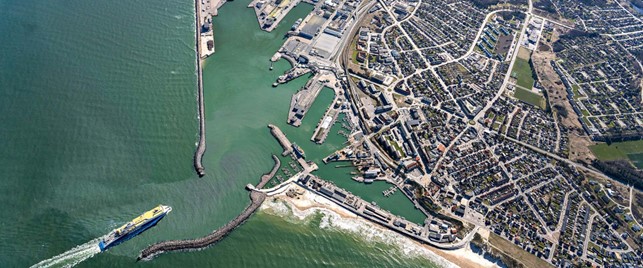Green hydrogen in the changing port energy landscape
A significant number of harbors and seaports today play an essential role as importing or exporting energy, handling large, fossil fuel flows of coal, oil, and natural gasses. The gas comes in, either via vessel, using specialized deep-sea terminals, or via pipeline, ending in the port area. Seaports are often home to large energy plants. The availability of land and cooling water, and the presence of large industrial customers, are some of the reasons for energy-producing firms to set up their business in seaport areas. While many wind farms are installed offshore, or in open plots in the hinterland, equally are several seaports home to wind farms, installed on breakwaters or stretches of land close to the sea. To transportation, seaports are equally providers for fueling stations.
Project “Grønn Jyllandskorridor” ensembles 26 partners across Norway and Denmark, and targets green transitions within transportations and 3 seaports partake in the consortium. In this article, we put a spotlight to the potential of green hydrogen and how seaports are in position to both accelerate and exploit opportunities that come about in the currently changing port energy landscape.
Seaports as drivers to the global hydrogen economy
The energy transition challenges existing energy hub ports, preparing them for a future decline in fossil-fuel-related activities, and for embracing the production, handling, and storage of renewables, including green hydrogen. Potentially, this may have far-reaching implications for ports. Green hydrogen is expected to assume a prominent role in an emerging new energy landscape in ports in future scenarios. Regulations are prompting the displacing of fossil fuel driven activities and whilst this challenges harbors to adjust their infrastructures, it equally places them in position to exploit new opportunities.
Indeed, ports can play a crucial role in the production and distribution of green hydrogen. They are important nodes, given existing and future local demand for hydrogen, the emerging offshore parks, and as junctions of transport nodes, some of which are already on the door to shift to hydrogen or related fuels (e.g., vessels, barges, trucks). Additionally, the infrastructure and handling capabilities of seaports make them prime locations for the storage and distribution of hydrogen. Moreover, seaports can serve as hubs for the export of green hydrogen to other countries, helping to drive the global transition to clean energy.
Seaports as Energy hubs for multimodal transport and logistics
Although quite a few initiatives for hydrogen export and import facilities have been announced in recent years and many are in pipeline, we are still in the early days of the creation of a global hydrogen carrier, shipping, and port network. At present, uncertainty remains on the preferred hydrogen carriers (i.e. there are several possible green hydrogen value chains with different carriers to hydrogen), cost is a critical factor (still a considerable production cost difference between green and blue/grey hydrogen.), also rules and regulations, safety standards and certification, and the impact these will have on hydrogen supply chains (for example, safety issues related to transport near urban areas) are still to be cleared.
All these uncertainties call for the alignment of efforts with standards and certification, through common sustainability criteria for traded and supported hydrogen, as well as the alignment of methodologies for hydrogen certification and efforts to set harmonized technical standards.
Looking across seaports globally, the green transition is already taking place, carried by innovative players where innovative seaports are establishing and demonstrating hydrogen closed-loop ecosystems, by deploying an innovative, economically viable and renewable energy system infrastructure. Within such frameworks, they set up plants to produce green hydrogen using renewable electricity generated in industrial areas of the port by for example windmills. Efficient downstream management of both hydrogen and electrolysis’ by-products, i.e. excess heat, oxygen, are enabled by an integrated and synergetic sector coupling, involving the greater value chain of the ports via pipeline infrastructure. Such set infrastructure allows for export opportunities, unlocking unseen value for the regions.
Collectively, flagship projects such as “Grønn Jyllandskorridor” come together in joint efforts to target opportunities and address challenges in the agenda of a sustainable transport network connecting Southern Norway, Western Sweden, and Jutland. Grønn Jyllandskorridor is a collaborative project between 26 partners with the aim of contributing to the development of more efficient and environmentally friendly multimodal transport in the Jutland Corridor and creating synergy between passenger and freight transport. Three ports: The ports of Kristiansand, Larvik and Hirtshals partake in the project.
Ports aiming for a strong position in green hydrogen are challenged to be active in all parts of the hydrogen value chain. A favorable location, a well-developed pipeline network, strong worldwide maritime connectivity, state-of-the-art terminal and logistics infrastructures, well-functioning and efficient industrial ecosystems, and a strong customer base, are all important factors enabling a seaport to take up an important, pioneering, role in an emerging hydrogen economy, positioning itself as a hydrogen import, transit, and production hub.

Illustration: The CCUS ecosystem presents a line of different paths for hydrogen in seaports securing usage in different applications, depending on existing infrastructure, and as either inland or to export.
Scalability is key
Most current scenarios do not foresee green hydrogen to play a significant role in Europe until 2030. Meanwhile, the extent to which important locations, such as seaports adapt their business to embrace hydrogen in its forms of green fuels alongside other intensives can accelerate this timing. Collaborations and share of knowhow for best-practice across corridors may equally play a role. Seaport Partners in Grønn Jyllandskorridor and the project’s missions are great examples to this.
- Port of Kristiansand is committed to sustainability and green solutions for the maritime industry. Serving as a driver for industry transition, the port supports operators and users of the port facilities in implementing projects aligned with sustainability. Ports play a vital role as energy hubs for multimodal transport and logistics, ensuring industrial growth, robust value chains, and secure transportation of goods, cargo, and people by sea. The Green Jutland Corridor project, involving 26 partners, underscores the importance of ports as key players in the transition to new energy carriers.
Isabelle-Louise Aabel, Communications Manager, Port of Kristiansand
- Port of Hirtshals places a strong emphasis on green solutions for both businesses and the transport sector. The port plays a crucial role as an energy hub for multimodal transport and logistics, ensuring the growth of the industry, resilient value chains, and secure transport of goods and cargo by road, rail, and sea. A strong partnering approach will enhance the port's ability to promote sustainable transport solutions in the industry, and to become a pioneer in introducing green energy solutions for railroad and maritime transport, thereby contributing to the reduction of greenhouse gas emissions at large. Port of Hirtshals is a strategically important port between Norway, Denmark, and Europe, actively working to establish valuable partnerships that foster collaboration and green transformation across borders.
Linn Indrestrand, Head of Fishery & Maritime Services
The port of Larvik works, in close cooperation with neighboring ports, purposefully to establish green solutions for the shipping industry. Standard, state of the art facilities for shore power-supply to ships in port will be established in 2024. Becoming a green energy hub for ships and vehicles is a major long-term goal, and the port supports operators in implementing relevant projects. We find our partnership in the Green Jutland Corridor project useful in this respect.
Jan Fredrik Jonas, Port Director, Port of Larvik



